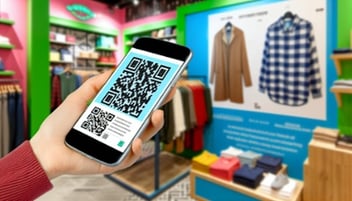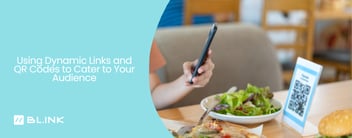
Listen to this blog
Marketing ROI of Television Advertising with QR Codes
Advertising with QR codes is a key way to capture engagement and marketing attribution, especially for offline marketing, including television advertising. Including QR codes in television ads can maximize customer engagement and drive conversions by providing instant access to relevant content. Here's how to use QR codes in television advertising.
Before using QR codes in TV ads, brands found measuring the real impact of television ads unwieldy, with most of the data coming from the television or media group itself. With BL.INK's ability to deliver real-time clicks and structured data that's reliable, brands can reliably measure higher engagement and conversion rates than the previous guesswork enabled.
Advertising with QR codes enables brands to interact directly with their target audience. Viewers can scan QR codes from television ads to visit a website or app that gives marketers new ways to convert viewers to buyers.
Television ads that include QR codes enable advertisers to engage users in real time while they’re watching TV. For example, if a commercial advertises a product that viewers are interested in, they can scan the QR code to go directly to the product’s website or app to learn more or purchase the product. Similarly, if a movie trailer is playing, viewers can scan the code and access bonus content related to the upcoming movie—such as cast interviews or behind-the-scenes footage—without having to leave the comfort of their couch. Brands can make the most of television advertising with QR codes by offering exclusive content only available during a specific show or event.
Adding QR codes to TV ads helps brands take advantage of today's hyper-connected audiences. Hyper-connectivity refers to the ability for multiple devices, platforms, networks, and services to be connected and interact with each other in a synchronized fashion. Synchronizing your content across all channels using QR codes, especially when incorporating personalization, builds brand trust and engagement.
People often have limited time and attention spans so being able to quickly access relevant information on the go is incredibly valuable for both parties involved. With BL.INK, you're able to track scans to the QR code in order to gain insights into your target audience which helps you to make informed decisions about future marketing campaigns and product releases.
QR codes in TV ads improve marketing ROI data, save costs
Television ads that contain QR codes enable brands to track user engagement in ways that are similar to tracking digital ads. With BL.INK, brands can see real-time scans and views from QR codes, which will help brands determine when and where viewers are most likely to interact with the QR codes in television ads.
Adding a QR code to an existing television ad is simple, usually not requiring additional video production or voiceover work. If you're running a television ad now, adding a QR code can be very cost-effective while giving viewers a new way to interact with your brand.
In some cases, companies have reduced their print ad budgets because they get more exposure and measurable interactions from their QR code-enabled television ads.
When a brand uses QR codes across its billboards, print, digital, and television ads, all the scan, view, and click data flows into the BL.INK platform in real time. This makes it easier to compile and measure the full marketing ROI on the campaign as a whole. This data is ready for analytics tools such as Adobe Analytics, Tableau, Bizible, Full Circle, and others. Since BL.INK delivers structured data for marketing analytics as part of its platform, marketing attribution is more accurate and reliable.
What's more, brands can put in-depth content on the destination pages, giving their prospects more ways to connect with them. For example, brands can encourage visitors to sign up for regular communications, enter sweepstakes, or to receive relevant text messages.
QR codes in TV ads can deliver unique experiences
With BL.INK Enterprise, users can create custom QR codes that are tailored to an individual’s needs. For example, a brand can create a QR code that matches their branding guidelines, including colors and logos. Customizing your own QR code allows you to make sure it’s clear who the QR code was created by ensuring that they trust the destination. This gives people an confidence in every scan, and can lead to more scans, and ultimately more conversions.
Additionally, BL.INK offers the ability to create dynamic QR codes. This allows you to redirect your visitors to relevant content based on different variables like day, date, time, location, language, and device. For example, if someone scans the QR code and is a native French speaker, the consumer can be routed to a page in French, based on the language their cell phone prefers. Brands can even deliver custom destination pages based on the time of day the viewer scans the code, or during a specific program.
For global brands, this can be extremely helpful in their campaigns. Let's say you have a campaign running but have users in 20 different countries. For your campaign, each country has their own landing page. Instead of creating 20 separate QR codes, you could create one QR code that redirects your visitor to the correct landing page for their country. Dynamic QR codes are an incredibly powerful feature, giving you the ability to better serve your customers with a seamless and personalized experience.
How to use QR codes in TV advertising
- The biggest mistake companies make with QR codes is pointing them to long, UTM-laden URLs. Create QR codes that link to shortened URLs so you can edit or customize the landing page for individual ads, time of day, or if your campaign changes. Discover more about BL.INK QR codes.
- When you add your QR code to your television ad, keep it live for the duration of the ad in one place so viewers have time to scan it. Make it large enough so it's easily scanned from across the room.
- Give viewers a compelling reason to scan the code, such as unlocking a discount, entering a contest, or accessing exclusive content.
- Track scans, views, and clicks to understand when and where viewers are engaging; this can also help confirm media placements and timing.
Best Practices for Tracking & Analyzing Results from QR Code Campaigns
QR codes have become an increasingly popular tool for businesses to use in their marketing campaigns. The ability to track and analyze the results of these campaigns is essential in order to measure their success. By tracking and analyzing data from QR code campaigns, businesses can gain valuable insights into how their efforts are performing, as well as identify areas that need improvement.
To ensure that you get the most out of your QR code campaigns, it is important to follow best practices for tracking and analyzing the results. This includes setting goals prior to launching your campaign, tracking engagement metrics such as click-through rates and conversion rates, monitoring customer feedback, and using analytics tools, like BL.INK, to measure performance. With this data in hand, you'll be able to make informed decisions about how to adjust your strategy for future campaigns and improve overall results.
Advantages of Incorporating QR Codes into TV Ads
QR codes have revolutionized the world of television advertising. They offer a unique way to engage viewers with promotions, special offers, and more. QR codes provide a direct link from an ad to the advertiser’s website or app, eliminating the need for cumbersome web addresses. This makes it easier for customers to find what they are looking for. Furthermore, QR codes can be used to personalize ads by providing targeted content with variable data. This helps advertisers deliver messages that are more relevant to their viewers. Additionally, using QR codes can help marketers measure the success of their campaigns through usage data, allowing them to adjust their strategies accordingly and improve ROI on their advertising budgets. All in all, incorporating QR codes into TV ads has many benefits and proves to be an invaluable marketing tool.
If you want to learn more about how your business can benefit from using QR codes in television ad campaigns, let's connect.



